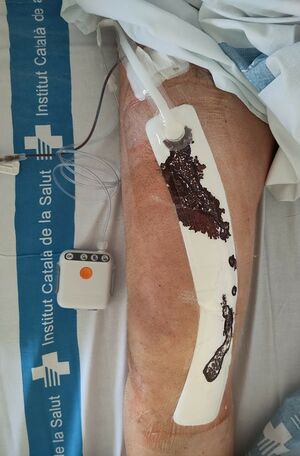Negative Pressure Wound Therapy Post Arthroplasty: Difference between revisions
No edit summary |
No edit summary |
||
| Line 5: | Line 5: | ||
</div> | </div> | ||
== Introduction == | == Introduction == | ||
Negative-pressure wound therapy (NPWT) has been successful used in the wound management of various surgical | Negative-pressure wound therapy (NPWT) has been successful used in the wound management of various surgical procedures. NPWT is the application of below atmospheric pressure to the wound, aiming to reduce inflammatory exudate and encourage granulation tissue. It use is mainly used in complex wounds which are non-healing (eg surgical site infections (SSI's), wound dehiscence) or at risk of non-healing eg diabetics and the obese<ref>Song QC, Li D, Zhao Y, Zhang GY, Shang DL, Fan LH, Dang XQ. [https://www.ncbi.nlm.nih.gov/pmc/articles/PMC9259126/ Negative pressure wound therapy reduces the incidence of postoperative wound dehiscence and surgical site infections after total knee arthroplasty in patients with obesity.] Medicine (Baltimore). 2022 Jul 8;101(27):e29641. doi: 10.1097/MD.0000000000029641. PMID: 35801735; PMCID: PMC9259126. Available:https://www.ncbi.nlm.nih.gov/pmc/articles/PMC9259126/ (accessed 23.12.2023)</ref><ref>Zaver V, Kankanalu P. [https://www.ncbi.nlm.nih.gov/books/NBK576388/ Negative Pressure Wound Therapy]. 2022 Sep 9. StatPearls [Internet]. Treasure Island (FL): StatPearls Publishing. 2023.Available:https://www.ncbi.nlm.nih.gov/books/NBK576388/ (accessed 23.12.2023)</ref>. Due to the calamitous consequences of infection following joint arthroplasty it has found a valuable use here. The pre-emptive use of NPWT after arthroplasty for those at high risk for postoperative wound drainage issues has the most robust clinical evidence. <ref>Siqueira MB, Ramanathan D, Klika AK, Higuera CA, Barsoum WK. [https://pubmed.ncbi.nlm.nih.gov/26807353/ Role of negative pressure wound therapy in total hip and knee arthroplasty.] World journal of orthopedics. 2016 Jan 1;7(1):30.Available: https://pubmed.ncbi.nlm.nih.gov/26807353/<nowiki/>(accessed 23.12.2023)</ref>. [[File:Negative pressure system used in surgical wound.jpg|center|thumb|NPWT: use in surgical wound]] | ||
== High Risk Subset == | == High Risk Subset == | ||
The major risk factors include: | The major risk factors include: | ||
Revision as of 08:46, 23 December 2023
Original Editor - Lucinda hampton
Top Contributors - Lucinda hampton and Kim Jackson
Introduction[edit | edit source]
Negative-pressure wound therapy (NPWT) has been successful used in the wound management of various surgical procedures. NPWT is the application of below atmospheric pressure to the wound, aiming to reduce inflammatory exudate and encourage granulation tissue. It use is mainly used in complex wounds which are non-healing (eg surgical site infections (SSI's), wound dehiscence) or at risk of non-healing eg diabetics and the obese[1][2]. Due to the calamitous consequences of infection following joint arthroplasty it has found a valuable use here. The pre-emptive use of NPWT after arthroplasty for those at high risk for postoperative wound drainage issues has the most robust clinical evidence. [3].
High Risk Subset[edit | edit source]
The major risk factors include:
- Obesity: negatively effects outcomes for those treated with TKA, with both increased short-term and long term complications. eg both SSIs and wound complications are associated with the TKA operations in the obese.
- Diabetics
- Tobacco Abuse
- Malnutrition
- Stress[4]
Viewing[edit | edit source]
This video demonstrates an optimal NPWT application with application tips, system use, and removal of the PICO System. NPWT is indicated for acute and chronic wounds and closed surgical incisions.
References[edit | edit source]
- ↑ Song QC, Li D, Zhao Y, Zhang GY, Shang DL, Fan LH, Dang XQ. Negative pressure wound therapy reduces the incidence of postoperative wound dehiscence and surgical site infections after total knee arthroplasty in patients with obesity. Medicine (Baltimore). 2022 Jul 8;101(27):e29641. doi: 10.1097/MD.0000000000029641. PMID: 35801735; PMCID: PMC9259126. Available:https://www.ncbi.nlm.nih.gov/pmc/articles/PMC9259126/ (accessed 23.12.2023)
- ↑ Zaver V, Kankanalu P. Negative Pressure Wound Therapy. 2022 Sep 9. StatPearls [Internet]. Treasure Island (FL): StatPearls Publishing. 2023.Available:https://www.ncbi.nlm.nih.gov/books/NBK576388/ (accessed 23.12.2023)
- ↑ Siqueira MB, Ramanathan D, Klika AK, Higuera CA, Barsoum WK. Role of negative pressure wound therapy in total hip and knee arthroplasty. World journal of orthopedics. 2016 Jan 1;7(1):30.Available: https://pubmed.ncbi.nlm.nih.gov/26807353/(accessed 23.12.2023)
- ↑ Wernick B, Nahirniak P, Stawicki SP. Impaired wound healing.Available:https://www.ncbi.nlm.nih.gov/books/NBK482254/ (accessed 23.12.2023)
- ↑ Smith & Nephew Wound US. Application of the PICO System after knee surgery. Available from: https://www.youtube.com/watch?v=wLXCETLv0nQ [last accessed 23.12.2023]







